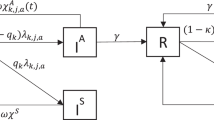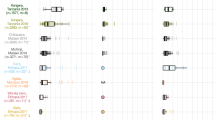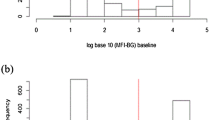Abstract
The World Health Organization has recommended repeat mass drug administration as part of their global initiative to eliminate blinding trachoma by the year 2020. The efficacy of repeat treatment will be tested empirically, but the results will not be available for many years, and recommendations for the necessary frequency of treatment are needed immediately. We have developed a mathematical model that uses available epidemiological data from a variety of countries. We recommend, based on our analysis, that in areas where trachoma is moderately prevalent (<35% in children), it should be treated annually, but hyperendemic areas (>50% in children), it should be treated biannually.
This is a preview of subscription content, access via your institution
Access options
Subscribe to this journal
Receive 12 print issues and online access
$209.00 per year
only $17.42 per issue
Buy this article
- Purchase on Springer Link
- Instant access to full article PDF
Prices may be subject to local taxes which are calculated during checkout




Similar content being viewed by others
References
Report of the First Meeting of the W.H.O. Alliance for the Global Elimination of Trachoma. (World Health Organization, Geneva, 1997).
Report of the Second Meeting of the W.H.O. Alliance for the Global Elimination of Trachoma. (World Health Organization, Geneva, 1998).
Schachter, J. et al. Azithromycin in control of trachoma 3. in Chlamydial Infections: Proceedings of the Ninth International Symposium on Human Chlamydial Infection (eds. Stephens, R. et al.) 347– 350 (International Chlamydia Symposium, Napa, California, 1998).
Mabey, D. et al. Azithromycin in control of trachoma 2. in Chlamydial Infections: Proceedings of the Ninth International Symposium on Human Chlamydial Infection (eds. Stephens, R. et al.) 351– 354 (International Chlamydia Symposium, Napa, California, 1998).
Dawson, C. et al. in Chlamydial Infections: Proceedings of the Ninth International Symposium on Human Chlamydial Infection (eds. Stephens, R. et al.) 352–355 (International Chlamydia Symposium, Napa, California, 1998).
West, S. et al. Nonocular Chlamydia infection and risk of ocular reinfection after mass treatment in a trachoma hyperendemic area. Invest. Ophthalmol. Vis. Sci. 34, 3194–3198 (1993).
Thylefors, B. The World Health Organization's programme for the prevention of blindness. Int. Ophthalmol. 14, 211– 219 (1990).
Muñoz, B. & West, S. Trachoma: the forgotten cause of blindness. Epidemiol. Rev. 19, 205–217 (1997).
McCormack, W.M. et al. Fifteen-month follow-up study of women infected with Chlamydia trachomatis. N. Engl. J. Med. 300, 123– 125 (1979).
Thygeson, P., Hanna, L., Dawson, C., Zichosh, J. & Jawetz, E. Inoculation of Human Volunteer with Egg Grown Inclusion Conjunctivitis Virus. Am. J. Ophthalmol. 53, 786–795 (1962).
Dawson, C.R. et al. Experimental inclusion conjunctivities in man: partial resistance to reinfection. Am. J. Epidemiol. 84, 411 –425 (1966).
Taylor, H.R. et al. Longitudinal study of the microbiology of endemic trachoma. J. Clin. Microbiol. 29, 1593– 1595 (1991).
Hayes, L.J. et al. Extent and kinetics of genetic change in the omp1 gene of Chlamydia trachomatis in two villages with endemic trachoma. J. Infect. Dis. 172, 268–272 (1995).
Bobo, L.D. et al. Severe disease in children with trachoma is associated with persistent Chlamydia trachomatis infection. J. Infect. Dis. 176, 1524–1530 (1997).
Ngochaduong, T. Medical Statistics, 1–75 (Masters thesis, London School of Hygiene and Tropical Medicine) (1995).
Courtright, P., Sheppard, J., Schachter, J., Said, M.E. & Dawson, C.R. Trachoma and blindness in the Nile Delta: current patterns and projections for the future in the rural Egyptian population. Br. J. Ophthalmol. 73, 536– 540 (1989).
Altman, L. Effort to halt blinding disease worldwide with single-dose drug. in The New York Times A1 and 7 ( 1998).
Steingrímsson, O. et al. Single dose azithromycin treatment of gonorrhea and infections caused by C. trachomatis and U. urealyticum in men. Sex. Transm. Dis. 21, 43–46 ( 1994).
Stamm, W.E. et al. Azithromycin for empirical treatment of the nongonococcal urethritis syndrome in men. A randomized double-blind study. J. Am. Med. Assoc. 274, 545–549 (1995).
Erdogru, T. et al. The treatment of non-gonococcal urethritis with single dose oral azithromycin. J. Int. Med. Res. 23, 386–393 (1995).
Magid, D., Douglas, J.M., Jr. & Schwartz, J.S. Doxycycline compared with azithromycin for treating women with genital Chlamydia trachomatis infections: an incremental cost-effectiveness analysis. Ann. Intern. Med. 124, 389–399 (1996).
Thorpe, E.M., Jr. et al. Chlamydial cervicitis and urethritis: single dose treatment compared with doxycycline for seven days in community based practises. Genitourin. Med. 72, 93– 97 (1996).
Hillis, S.D. et al. Doxycycline and azithromycin for prevention of chlamydial persistence or recurrence one month after treatment in women. A use-effectiveness study in public health settings. Sex. Transm. Dis. 25, 5–11 (1998).
Wehbeh, H.A., Ruggeirio, R.M., Shahem, S., Lopez, G. & Ali, Y. Single-dose azithromycin for Chlamydia in pregnant women. J. Reprod. Med. 43, 509 –514 (1998).
Bianchi, A. et al. Kinetics of Chlamydia trachomatis clearance in patients with azithromycin, as assessed by first void urine testing by PCR and transcription-mediated amplification. Sex. Transm. Dis. 25, 366 –367 (1998).
Blower, S. & Dowlatabadi, H. Analysis of Complex Models of Disease Transmission: an HIV Model, as an Example. Int. Stat. Rev. 62, 229–243 ( 1994).
Dietz, K. Models for parasitic disease control. Bull. Int. Stat. Inst. 40, 531–544 (1975).
Dietz, K. & Renner, H. in Lecture Notes in Biomathemtics , Vol. 57 (eds. Capasso, V., Grusso, E. & Paveri-Fontana, S.L.) 115–126 (Springer-Verlag, New York, 1985).
Tielsch, J.M. et al. The epidemiology of trachoma in southern Malawi. Am. J. Trop. Med. Hyg. 38, 393–399 (1988).
Taylor, H.R. et al. The epidemiology of infection in trachoma. Invest. Ophthalmol. Vis. Sci. 30, 1823–1833 (1989).
Ward, M. et al. Persisting inapparent chlamydial infection in a trachoma endemic community in The Gambia. Scand. J. Infect. Dis. Suppl. 69, 137–148 (1990).
Baral, K. et al. Reliability of the Ocular Examination in Detecting Chlamydia in an Area of Nepal with a Low Prevalence of Trachoma. Bull. World Health Org. (in the press).
Bailey, R.L. et al. Molecular epidemiology of trachoma in a Gambian village. Br. J. Ophthalmol. 78, 813–817 (1994).
Bailey, R., Osmond, C., Mabey, D.C., Whittle, H.C. & Ward, M.E. Analysis of the household distribution of trachoma in a Gambian village using a Monte Carlo simulation procedure. Int. J. Epidemiol. 18, 944–951 (1989).
Arno, J.N. et al. Age and clinical immunity to infections with Chlamydia trachomatis. Sex. Transm. Dis. 21, 47– 52 (1994).
Schachter, J. & Dawson, C. in Human Chlamydial Infections, 35 (PSG Publishing, Littleton, Massachusetts, 1978).
Bailey, R.L., Arullendran, P., Whittle, H.C. & Mabey, D.C. Randomised controlled trial of single-dose azithromycin in treatment of trachoma. Lancet 342, 453–456 (1993).
Anderson, R. & May, R. in Infectious Diseases of Humans: Dynamics and Control, 62, 172–192 (Oxford University Press, Oxford, 1991).
Assad, F.A. & Maxwell-Lyons, F. The use of catalytic models as tools for elucidating the clinical and epidemiological features of trachoma. Bull. World Health Org. 34, 341– 355 (1958).
Muñoz, B., West, S. & Aron, J. Dynamics of transmission and progression of trachoma in hyperendemic areas in Annual Meeting of the Society for Mathematical Biology (Oaxtepec, Mexico, 1995).
Ward, M., Hawkins, J. & Shahani, A. in Proceedings of the Seventh International Symposium on Human Chlamydial Infection (eds. Bowie, W. & Robert, W.) 591–594 (Cambridge University Press, Harrison Hot Springs, Canada, 1990).
Blower, S.M., Small, P.M. & Hopewell, P.C. Control strategies for tuberculosis epidemics: new models for old problems. Science 273, 497 –500 (1996).
Blower, S.M., Hartel, D., Dowlatabadi, H., Anderson, R.M. & May, R.M. Drugs, sex and HIV: a mathematical model for New York City. Phil. Trans. R. Soc. Lond. B. Biol. Sci. 331, 171–187 ( 1991).
Blower, S.M. et al. The intrinsic transmission dynamics of tuberculosis epidemics. Nature Med. 1, 815–821 (1995).
Porco, T.C. & Blower, S.M. Quantifying the intrinsic transmission dynamics of tuberculosis. Theor. Popul. Biol. 54, 117–132 (1998).
Blower, S.M., Porco, T.C. & Darby, G. Predicting and preventing the emergence of antiviral drug resistance in HSV-2. Nature Med. 4, 673–678 (1998).
Sanchez, M.A. & Blower, S.M. Uncertainty and sensitivity analysis of the basic reproductive rate. Tuberculosis as an example. Am. J. Epidemiol. 145, 1127–1137 (1997).
Hethcote, H. in Modeling Heterogeneous Mixing in Infectious Disease Dynamics. Models for Infectious Human Diseases: Their Structure and Relation to Data (eds. Isham, V. & Medley, G.) 215–238 (Cambridge University Press, Cambridge, 1996).
Gupta, S., Anderson, R.M. & May, R.M. Networks of sexual contacts: implications for the pattern of spread of HIV. AIDS 3, 807– 817 (1989).
Dawson, C.R., Daghfous, T., Messadi, M., Hoshiwara, I. & Schachter, J. Severe endemic trachoma in Tunisia. Br. J. Ophthalmol. 60, 245– 252 (1976).
West, S.K., Munoz, B., Turner, V.M., Mmbaga, B.B. & Taylor, H.R. The epidemiology of trachoma in central Tanzania. Int. J. Epidemiol. 20, 1088– 1092 (1991).
Acknowledgements
We thank E. Ziv, H. Gershengorn, K. Koelle, S. Osaki, J.P. Whitcher and J. Schachter fokr comments and A. Edgecombe for technical assostance. We are grateful to the National Institute of Allergy and Infectious Diseases (Grants K08 Al 01-441-0 and 1R01 A1 41935).
Author information
Authors and Affiliations
Corresponding author
Rights and permissions
About this article
Cite this article
Lietman, T., Porco, T., Dawson, C. et al. Global elimination of trachoma: How frequently should we administer mass chemotherapy?. Nat Med 5, 572–576 (1999). https://doi.org/10.1038/8451
Received:
Accepted:
Issue Date:
DOI: https://doi.org/10.1038/8451
This article is cited by
-
Uses of mathematical modeling to estimate the impact of mass drug administration of antibiotics on antimicrobial resistance within and between communities
Infectious Diseases of Poverty (2022)
-
Trachoma
Nature Reviews Disease Primers (2022)
-
Dynamics of Trachoma Epidemic in Human Contact Network with Seasonally Varying Infectious Medium
Proceedings of the National Academy of Sciences, India Section A: Physical Sciences (2021)
-
The utility of serology for elimination surveillance of trachoma
Nature Communications (2018)
-
The impact of a single round of community mass treatment with azithromycin on disease severity and ocular Chlamydia trachomatis load in treatment-naïve trachoma-endemic island communities in West Africa
Parasites & Vectors (2017)



